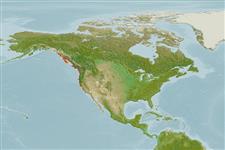Environment: milieu / climate zone / depth range / distribution range
Écologie
marin démersal; profondeur 0 - 18 m (Ref. 2850). Subtropical; 59°N - 34°N, 156°W - 118°W
Eastern Pacific: Port San Juan, southeastern Alaska to Santa Cruz Island, southern California, USA.
Taille / Poids / Âge
Maturity: Lm ? range ? - ? cm
Max length : 58.0 cm TL mâle / non sexé; (Ref. 2850); âge max. reporté: 11 années (Ref. 56049)
Description synthétique
Clés d'identification | Morphologie | Morphométrie
Épines dorsales (Total) : 71 - 77; Rayons mous dorsaux (Total) : 0; Épines anales: 0; Rayons mous anaux: 46 - 50. Caudal small and rounded, directed upward; pectorals as minute flaps (Ref. 6885). Greenish black with several dusky white bars on posterior part of body, 2 dark bands diverging back from each eye, each band double with a paler center (Ref. 6885).
Facultative air-breathing (Ref. 126274); Found in rocky areas, from intertidal to 18 m depth, mostly on exposed coast (Ref. 2850). May remain out of water under rocks or seaweed (Ref. 31184). Feed mainly on algae (Ref. 6885). Oviparous, eggs are laid in several clumps or masses which are guarded by the male (Ref. 58332). Breathe air (Ref. 31184) and can stay out of water for 17-23 hours if kept moist (Ref. 51276).
Female lays eggs in a cluster under a rock, male guards the egg mass by wrapping his body around it (Ref. 2850)
Eschmeyer, W.N., E.S. Herald and H. Hammann, 1983. A field guide to Pacific coast fishes of North America. Boston (MA, USA): Houghton Mifflin Company. xii+336 p. (Ref. 2850)
Statut dans la liste rouge de l'IUCN (Ref. 130435)
Menace pour l'homme
Harmless
Utilisations par l'homme
Outils
Articles particuliers
Télécharger en XML
Sources Internet
Estimates based on models
Preferred temperature (Ref.
123201): 8.9 - 12.8, mean 10.1 °C (based on 164 cells).
Phylogenetic diversity index (Ref.
82804): PD
50 = 0.7500 [Uniqueness, from 0.5 = low to 2.0 = high].
Bayesian length-weight: a=0.00102 (0.00046 - 0.00225), b=3.06 (2.88 - 3.24), in cm total length, based on all LWR estimates for this body shape (Ref.
93245).
Niveau trophique (Ref.
69278): 2.2 ±0.1 se; based on diet studies.
Résilience (Ref.
120179): Faible, temps minimum de doublement de population : 4,5 à 14 années (tm=5; tmax=11; Fec-9,500).
Fishing Vulnerability (Ref.
59153): Moderate vulnerability (43 of 100).
